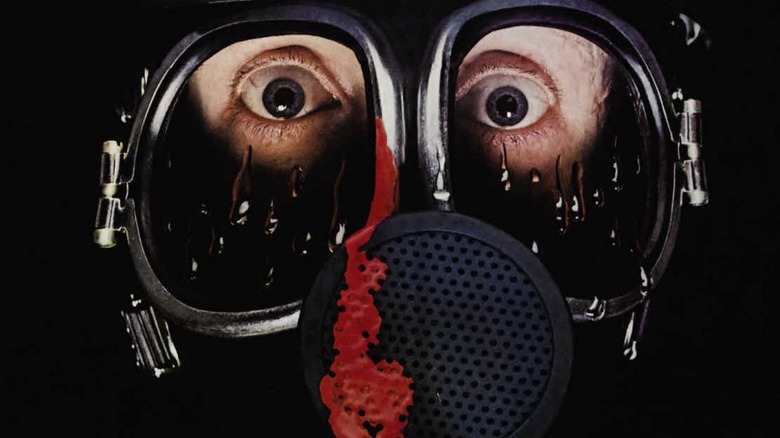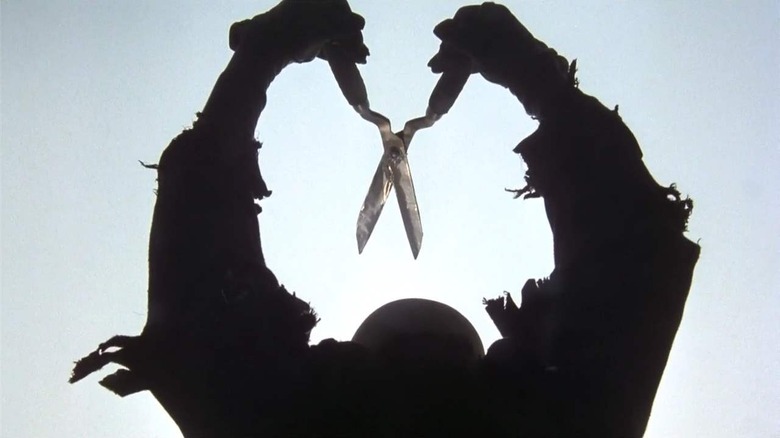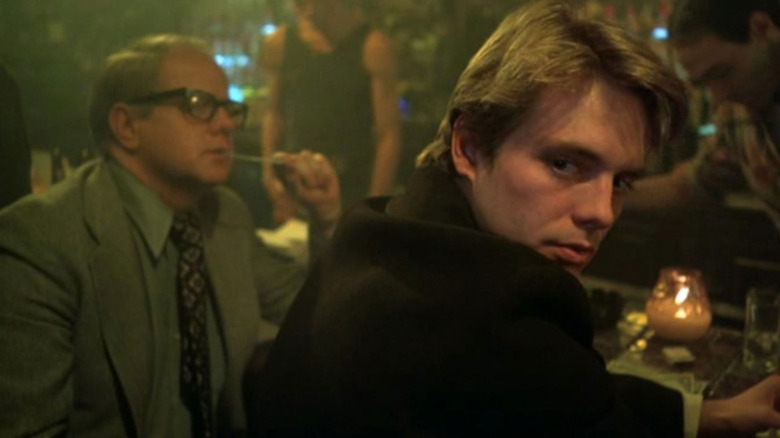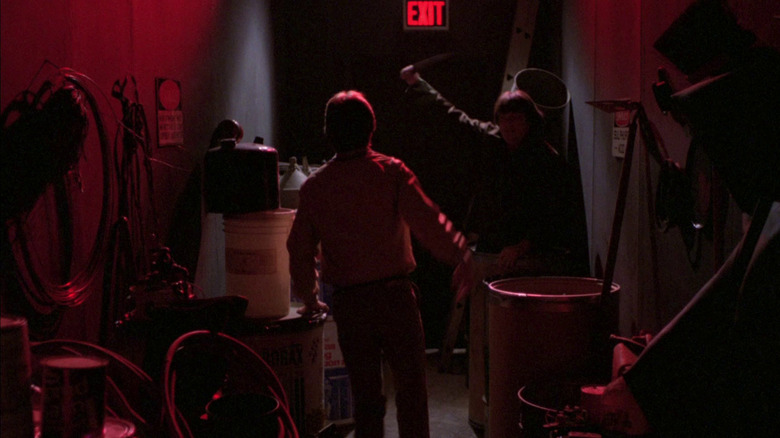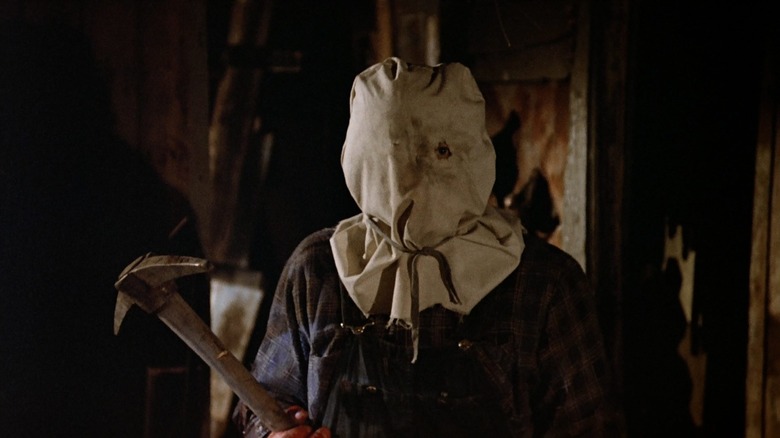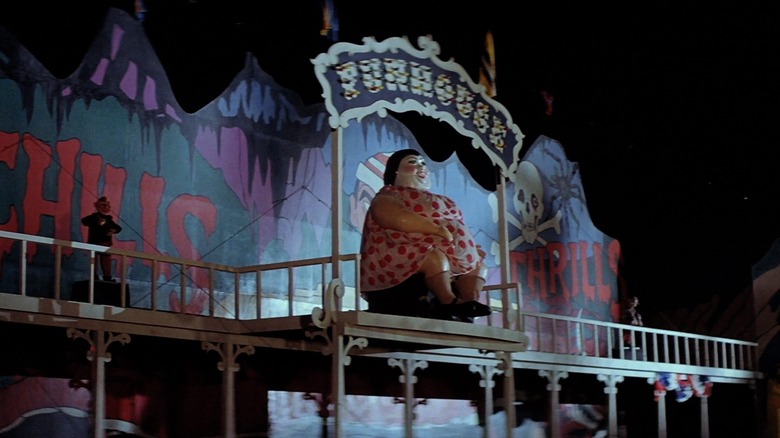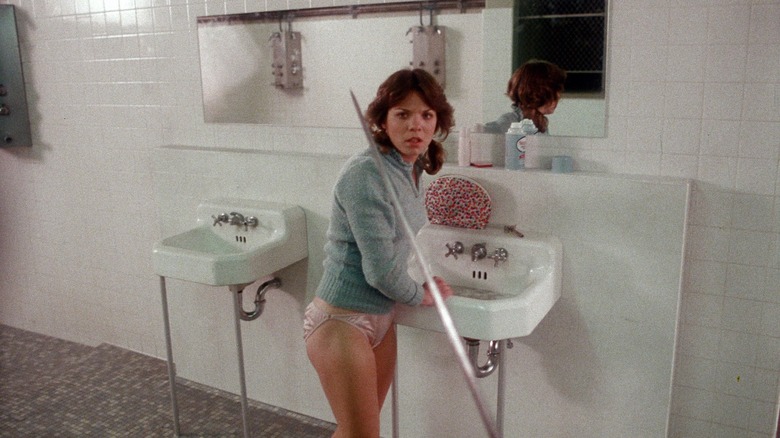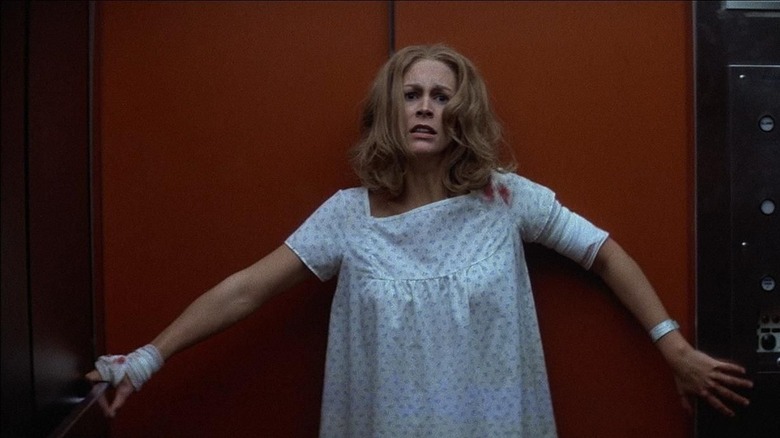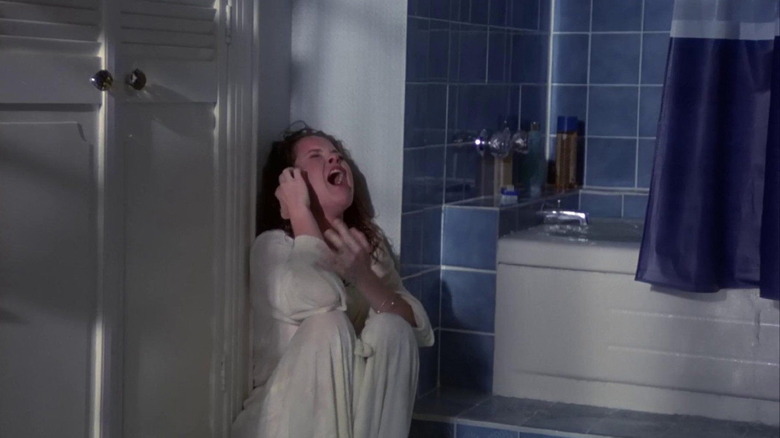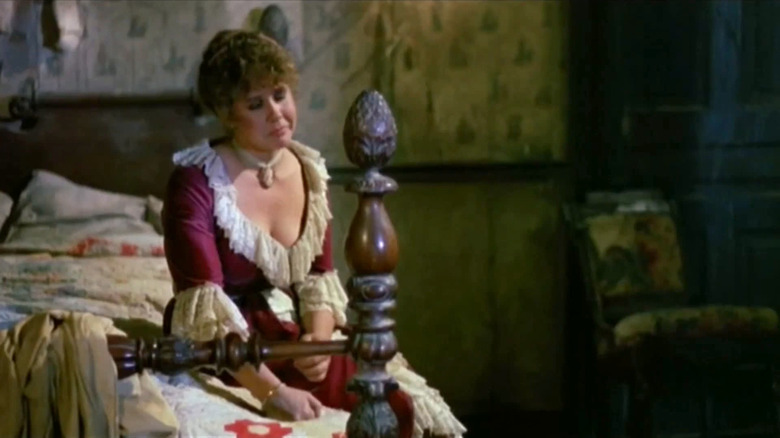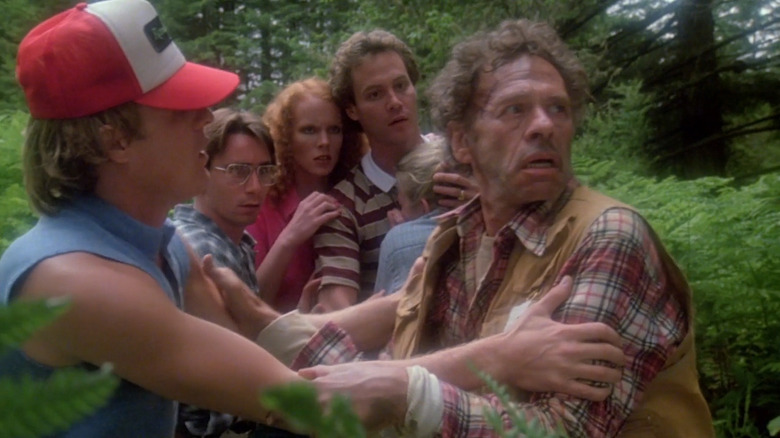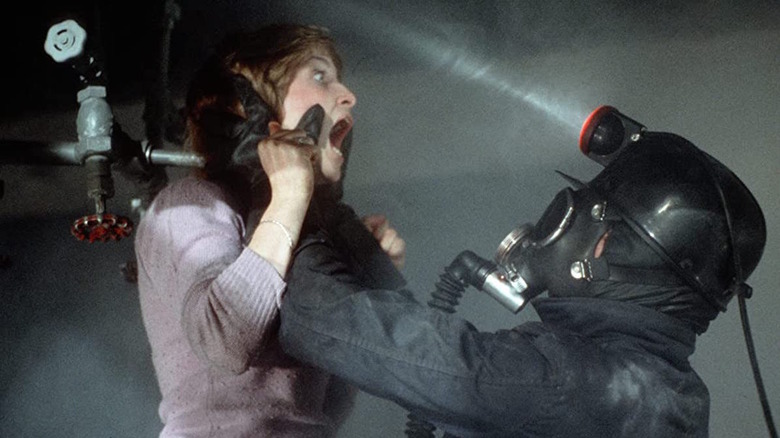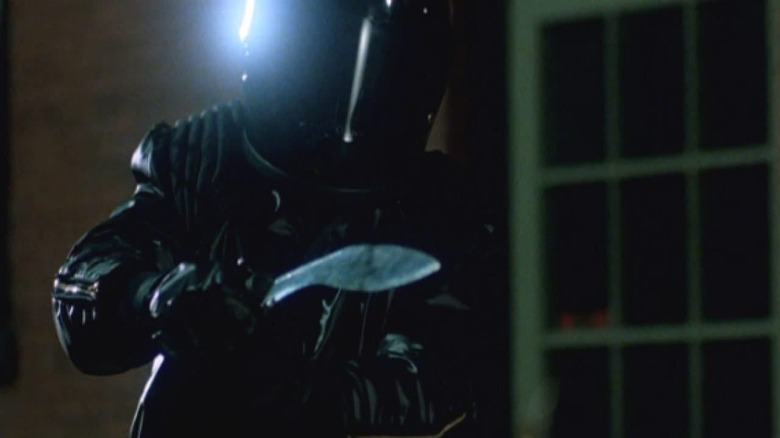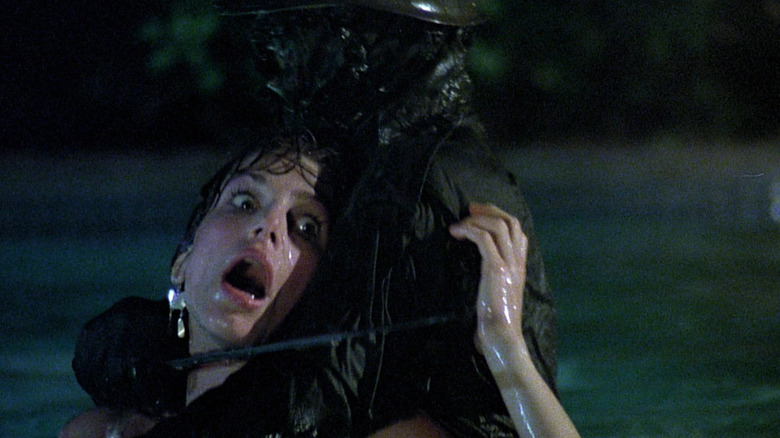The Best Slashers Turning 40 This Year
There's no consensus about the origin of the slasher film. "Halloween," which came out in 1978, perfected the tropes, though 1974's "Black Christmas" came first. Many genre purists will point to 1960's one-two punch of "Psycho" and "Peeping Tom" as the beginning of the genre. However, regardless of how it started, the horror subgenre truly hit its stride in 1980 and 1981, when virtually every horror film aimed to capitalize on the financial success of 1980's "Friday the 13th."
But not every slasher is created equal, and 1981 proved to be something of a rollercoaster in terms of quality. This was the last year of the slasher boom — it was the beginning of the end for the subgenre, as a wave of mediocre films led to audience exhaustion, as well as accusations of tawdriness from critics and politicians. As such, 1981 is the crest before the fallow period that lasted until "Scream" exploded onto the scene in 1996.
With that in mind, in celebration of the titles turning 40 this year, let's revisit the best American slasher films released in 1981. Spoilers follow.
The Burning
Slashers love to focus on pranks and urban legends, so it makes sense that "The Burning" would use both as its inciting incident. It begins with the legend of Cropsy, a caretaker (Lou David) who is inadvertently set ablaze by campers in a prank gone wrong. Five years later the man, now horribly burned, returns to camp to wreak revenge on both the counsellors and their new, young charges.
Some of those youngsters, including Jason Alexander, Holly Hunter, and Fisher Stevens, would become famous, but it is the gore and the practical effects that are the true heroes of the film. One fan favorite: the raft scene in which Cropsy lunges out of the shallow water with his iconic garden shears and begins hacking kids apart in glorious slow motion.
Sadly, this is the first of many films on this list that was heavily censored by the MPAA over concerns about violent media. While that stigma didn't hurt other films, "The Burning" was a flop at the time of its release, barely making back half of its $1.5 million budget. Thankfully the film has found new life as a cult classic in the interceding years. Just ignore the Weinstein connection.
The Fan
The '80s were defined by conservatism (thanks, Reagan), but in 1981, that was all still in its infancy. Ditto the mysterious illness that would eventually be known as HIV and AIDS. These sociopolitical elements, however, contribute to a legacy of negative depictions of the queer community (see, for example, Brian De Palma's 1980 slasher "Dressed to Kill," which uses a "man in a dress" reveal as a shock tactic).
"The Fan" is has similar problems. The film follows Douglas Breen (Michael Biehn), a queer-coded man who obsessively stalks aging Broadway star Sally Ross (Lauren Bacall), slashing anyone who gets in his way. It's actually a very silly, campy film, particularly Bacall's less than enthusiastic performance during her dancing and singing scenes, but a few key moments stand out in stark contrast.
One is a scene in which Breen, either acting on his latent homosexuality or using his good looks to murderous advantage, takes a man home for oral sex. This unfortunate gay man is killed and framed by Breen in order to misdirect the police. It's a startling case of a hate crime handled very nonchalantly; the murder is simply another set piece. "The Fan" is ridiculous fun and worth checking out for hunky young Biehn and his melodramatic fan letters. However, as a text that traffics in queer culture, it does have a harmful legacy.
Final Exam
One of the lesser-known entries on this list, Jimmy Huston's "Final Exam" is a different kind of slasher. The logline — a madman stalks a college campus, killing coeds before he is ultimately defeated by a final girl — looks identical to 1981's other slashers. In reality, though, the film has two unique characteristics.
The first is the film's lengthy, dialogue-heavy sequences as Lanier College student Courtney (Cecile Bagdadi) and her friends prepare for their exams. Oddly, this doesn't help make the film's characters three dimensional or well-rounded; in fact, the film often feels strangely dull and lifeless. That's surprising, considering that "Final Exam" also features a fake school shooting, as well as a ridiculous climactic moment during which the killer catches an arrow in mid-air.
Its second unique element is the identity and motivation of the killer. Unlike other slasher films, which prioritize unmasking the murderer, "Final Exam" never explains who the villain is or why they're killing coeds. The arbitrary and unknowable nature of the crimes is arguably the film's most fascinating component.
Friday the 13th Part 2
The original "Friday the 13th" is a classic for numerous reasons: It's the first entry in what would become a beloved franchise, it defines the formula (derived from selected aspects of "Halloween") for nearly all subsequent slashers, and it features a rare-for-the-genre female antagonist in Mrs. Voorhees (Betsy Palmer, in an iconic performance).
In much the same way that "Halloween 2" built out from "Halloween," "Friday the 13th Part 2" takes what worked in the original and runs with it. In addition to capitalizing on the sexy, sweaty teens of the first film, "Part 2" introduces the waterlogged son of Mrs. Voorhees and, in the process, forever changes the direction of the franchise.
While Jason Vorhees wouldn't come into possession of his iconic hockey mask until "Part 3," audiences ate up the new, unkillable monster to the tune of $21.7 million and, in the process, kickstarted one of the most inventive and enduring horror franchises of the 20th century. It's ironic that so many titles on this list never become a franchise, considering that several cost less and grossed more than "Friday the 13th Part 2." Perhaps that's just a testament to the enduring power of bag-head Jason!
The Funhouse
The setting of "The Funhouse" is undeniably a huge part of its appeal. Considering how visually memorable a carnival is and the setting's limitless potential for horror, it's surprising that so few films have featured murders under the big top.
Another strong selling point of the film is its director, Tobe Hooper. "The Funhouse" is only the second film the Master of Horror released after his trailblazing efforts on 1974's "The Texas Chainsaw Massacre," another film that is often overlooked in discussions of classic slashers. Unlike many of his contemporaries, Hooper's foray into '80s slasher territory was met with a warm reception from critics, many of whom argued that the film has a stronger visual style than the other "Friday the 13th" knockoffs. Audiences agreed, propelling the film to nearly $8 million in theatres, more than double its $3 million production budget.
It doesn't hurt that the setting is so evocative and its villain is so threatening. Although the film traffics in ableist tendencies in its treatment of a deformed killer (played menacingly by Wayne Doba), "The Funhouse" remains a genuinely atmospheric and tense slasher that deserves more credit and accolades. Seek this one out if you haven't seen it — it's worth your time.
Graduation Day
Not every slasher film is created equal. "Graduation Day," about a killer who stalks a track and field team, highlights where the priorities of the subgenre were in 1981. The film follows Anne (Patch Mackenzie), the older sister of a high school athlete who dies in the film's opening sequence. As Anne investigates Coach Michaels (Christopher George), who notoriously pushes his athletes past their breaking point, various members of the team are killed off in inventive and gory ways.
It's no surprise that slasher films in 1981 were fixated on gory deaths — this was the lesson studios took from the massive financial success of "Friday the 13th." What distinguishes "Graduation Day" from its contemporaries is the fact that nearly all of the deaths are sports-related, which results in some truly creative set pieces. A personal favorite is a javelin death, which makes perfect sense given the film's focus on track, but still manages to feel fresh and innovative.
Despite tepid reviews, "Graduation Day" was a huge success, grossing $24 million on a $250,000 budget. This fact serves to confirm just how popular the slasher subgenre was at the time. Like so many '80s films, the film has also gained a cult following over the years.
Halloween 2
1981 introduced sequels to two iconic slasher films. "Friday the 13th Part 2" is rightfully recognized as one of the franchise's best because it retains the original film's flavor while simultaneously introducing a mythology that takes the franchise in new and exciting directions.
"Halloween 2" doesn't have the same goodwill from the audience as "Friday the 13th Part 2," in part because the Michael Myers sequel is the follow-up to one of the subgenre's most beloved entries. When the sequel arrived, sans Carpenter in the director's chair and with a near-comatose Laurie Strode (Jamie Lee Curtis) and gallons more blood, critics decried the franchise's shift into conventional slasher territory. Where "Halloween" was considered reserved and sophisticated, its successor is more aligned with "Friday the 13th" in terms of both aesthetics and ostentatious kills.
Regardless of complaints about the change in direction, the $2.5 million-budgeted film made boatloads of cash ($25 million) and features several outstanding, if mean, set pieces (poor Head Nurse Alves). As a sequel to the original, "Halloween 2" does feel more sensational, but much like "Friday the 13th Part 2," the sequel reflects how slashers became increasingly violent between 1978 and 1981.
Happy Birthday to Me
Actresses have been taking edgy film roles to help shed their nice girl personas for decades. Exhibit A: Melissa Sue Anderson's role in "Happy Birthday to Me." The slasher is one of many Tax Shelter Era films of the late '70s and early '80s, when Hollywood productions came to Canada to take advantage of tax breaks to make a quick buck. And nothing's cheaper than slashers, which is why so many stalk-and-slash films of this period have a distinctly Hollywood North vibe.
"Happy Birthday to Me" has a loose Freudian plot centered around Ginny (Sue Anderson), a member of Crawford Academy's popular crowd. Naturally, the group begins to get picked off one by one, which has everything to do with Ginny's repressed memories of a booze and water-related accident involving her deceased mother.
The film's movie poster and tagline are its greatest selling point. The former features Steve (Matt Craven) being orally penetrated by a kebab, while the latter promises "Six of the most bizarre murders you will ever see." This, Sue Anderson's attempt to break free of her "Little House on the Prairie" character, and the film's nonsensical ending, make "Happy Birthday to Me" one of the most unusual slashers of the decade. This wackadoodle gem truly has to be seen to be believed.
Hell Night
Don't let the fact that Linda Blair was nominated for a Razzie for her performance as Marti Gaines in "Hell Night" deter you from checking it out. The film, directed by Chuck Russell (pre-"Nightmare on Elm Street 3: The Dream Warriors" and "The Blob" remake), is actually really enjoyable.
Like a few other titles on this list, "Hell Night" features an urban legend, although it's one fabricated for the film. The pledges of Alpha Sigma Rho are sequestered in the deserted Garth Manor, which is infamous for the titular family's murder-suicide and alleged haunting. Naturally, there are also pranks: Marti and the three other pledges are locked in the manor at the behest of Peter Bennett (Kevin Brophy), who has set up numerous tricks and traps to scare them. Alas, things don't go to plan when an assailant begins trying to murder Marti and her friends.
To say much more would spoil the twist (which, ironically, also applies to the next entry), but "Hell Night" is a charming entry in this first cycle of slashers. Blair is a capable lead and the Victorian costumes lend the film a gothic vibe. Sure, the plot isn't great (something critics complained about at the time), but the film certainly deserved better than its $2.3 million gross. For shame, slasher fans — go support this underdog entry!
Just Before Dawn
The line demarking a slasher from any other horror subgenre is fluid and extremely malleable. Case in point: hillbilly or rural films, in which characters are chased through the woods or abandoned Midwestern landscapes, as opposed to the city. Another distinguishing characteristic of this subgenre is that the villains are typically poorly educated and often inbred, which gives rural slashers a specific class-based reading. There's a lot to unpack in these films, but they're lumped into the broader slasher canon because they share many of the same tropes.
"Just Before Dawn" follows a group of friends on a camping trip who meet a young girl, Merry Cat Logan (Katie Powell), who tries to help them when they are attacked by wild persons living in the Oregon mountains. If that description seems familiar, director Jeff Lieberman claims on a DVD commentary that he hadn't seen "The Texas Chainsaw Massacre" or "The Hills Have Eyes" when he made his film.
While being set outside of the city and exploring different class relationships distinguishes "Just Before Dawn" from its contemporaries, the film is no less effective. In fact, it's really tense and exciting. The film also contains one of the absolute best climactic moments of any slasher film, although it rarely gets its dues in horror circles. If you haven't seen "Just Before Dawn," schedule a trip to the mountains immediately.
My Bloody Valentine
Bear with me as I hum "The Ballad of Harry Warden," the theme song for this quintessentially Canadian slasher. Like many films of its ilk, "My Bloody Valentine" takes a historical tragedy as its inciting incident — in this case, it is a mine explosion that occurs when distracted employees abandon their posts in anticipation of a Valentine's Day dance.
"My Bloody Valentine" centers its drama on a stilted romantic triangle between Sarah (Lori Hallier) and her two love interests, TJ (Paul Kelman) and Neil Affleck's Axel (in reality, the pair of dudes seem more interested in each other than in Sarah). Compared to other movies on this list, this is an unconventionally horny slasher film: Characters are interested in fornicating in mine shafts, and TJ is unable to do up more than half of the buttons on his shirts. Chalk these quirks up to the film's wholesome Canadian charm. Not only was "My Bloody Valentine" shot in a real Nova Scotia mine (which caused no shortage of production woes), it was seemingly sponsored by local brewery Moosehead.
Tragically, the film also suffers from some of the most aggressive MPAA cuts at the time. While the film broke even financially, it's unclear how much the edits hurt its box office. Thankfully, the gory footage is included in recent Blu-ray releases, so this classic slasher masterpiece is available in its full glory.
Night School
"Night School" has rightfully been described as a giallo thanks to its leather-clad killer, international cast, and police procedural elements. It's also inherently adult, with a cast of mature characters and a motivation driven by jealousy, as well as the murderer's desire to protect her burgeoning family.
The film follows Lieutenant Judd Austin (Italian actor Leonard Mann), a workaholic police officer who is investigating a string of decapitations around Boston. The killings are all tied to a women's night school — more specifically, the school's womanizing anthropology professor, Vincent Millett (Drew Snyder). It's hardly a surprise when it is revealed that Millett's pregnant girlfriend, Eleanor Adjai (English-Australian actress Rachel Ward) is the killer cleaning up after her philandering baby daddy. A female killer is a rarity, although "Night School" awkwardly tows the line between female empowerment (Adjai has agency) and reductive conservative values (she's killing other women for her worthless man).
What works best about "Night School" is its mix of American and European sensibilities. The international cast, the sleazy exploitation vibes, and the stylish direction, particularly the aquarium shower room (a bloody favorite) makes the film memorable. "Night School" isn't the most innovative film, but it does feel unique among 1981 slashers.
The Prowler
There's a significant amount of overlap between "The Prowler" and "My Bloody Valentine." They both open with a murder that freezes their respective small towns in amber before jumping to the present day, when enterprising teens attempt to organize a dance that inevitably leads to disaster.
Sadly, the rest of the film is bland and uninspired, especially the combative relationship between final girl Pam (Vicky Dawson) and her paramour, Deputy Mark (Christopher Goutman). The editing by Joel Goodman and flat direction by Joseph Zito makes for sluggish pacing. More frustratingly, the audience is stuck with Pam and Mark for long stretches. It's perplexing, because neither are interesting enough to justify their screen time.
Aside from some epic kills courtesy of Tom Savini, including an iconic slow-motion head explosion in the climax, there's simply not enough here. "The Prowler" may have its fans, but it's not the best that 1981 had to offer.
